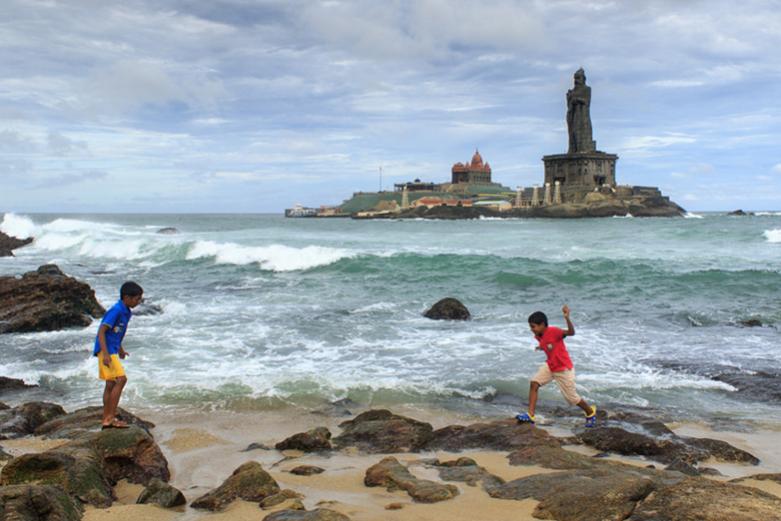
- Quick contact : 9447749270

VIVEKANANDA ROCK
Vivekananda Rock Memorial is dedicated to Swami Vivekananda, a disciple of Sri Ramakrishna Paramahamsa, the founder of Ramakrishna Mission. Vivekananda Rock Memorial was built between 1963 and 1970 in red and blue granite. It is situated on the top of a rock island, at a height of about 17 meters above sea level, covering an area of about 6 acres.
Vivekananda Rock Memorial is about 490 meters offshore nearby the confluence of the Arabian Sea, Bay of Bengal and Indian Ocean. In 1970, Swami Vireshwarananda, the president of Ramakrishna Mission, consecrated Vivekananda Rock Memorial and it was opened to the public by V.V. Giri, the then President of India.
Vivekananda Rock Memorial consists of two main structures – Vivekananda Mandapam and Shripada Mandapam. Shripada Mandapam is situated on Shripada Parai, an ancient sacred spot believed to be blessed by Goddess Kanyakumari.
It is believed that Swami Vivekananda swam across the sea to Shripada Parai for deep meditation and enlightenment. As per legends, it was on Shripada Parai that Goddess Kanyakumari did meditation. The footprint on Shripada Parai is believed to be that of Goddess Kanyakumari.
Vivekananda Mandapam of Vivekananda Rock Memorial has a rectangular floor plan and it has four parts – Dhyana Mandapam (Meditation Hall), Sabha Mandapam (Assembly Hall), Mukha Mandapam (Front Portion) and the Front Entrance.
Dhyana Mandapam has six rooms adjacent to it. Sabha Mandapam encloses Pralima Mandapam, two rooms and a corridor and it has an open Prakaram around it. In the Pralima Mandapam there is a statue of Swami Vivekananda.
Shripada Mandapam has a square floor plan and it includes Garbha Graham (Sanctum Sanctorum), Inner Prakaram, Outer Prakaram and an Outer Platform. The Outer Platform surrounds the Shripada Mandapam.
Vivekananda Mandapam and Shripada Mandapam are designed in such a way that the vision of Swamiji’s statue in Pralima Mandapam is directed towards the Shripadam. The different architectural styles of India have been incorporated in the construction of the Vivekananda Rock Memorial.
Ferry services connect the mainland to the rocky island. The ferry fees to reach Vivekananda Rock Memorial are INR20 for adults and INR10 for students

THIRUVALLUVAR STATUE
Thiruvalluvar Statue is a popular tourist spot in Kanyakumari. Thiruvalluvar Statue is one of the biggest statues in India located atop a small island in Kanyakumari, nearby the confluence of the Arabian Sea, Bay of Bengal and Indian Ocean.
Thiruvalluvar Statue was built in the year 2000 to commemorate Thiruvalluvar who was a renowned ancient Tamil saint and poet who wrote Thirukkural.
The statue of Thirukkural stands on a 3 – tier pedestal, known as Atharapeedam. Atharapeedam is surrounded by the 38 feet high Alankara Mandapam. There are ten elephant statues surrounding the Alankara Mandapam that symbolise the ten directions – eight for earth, one for sky and one for the space down.
The statue of Thiruvalluvar is so designed that it reflects the structure of Thirukkural. Thirukkural, ‘The Sacred Couplets’, has three sub sections, which are the Books of Aram, Porul and Inbam.
The total height of the sculpture of Thiruvalluvar is about 133 feet, which corresponds to the total number of chapters in the Book of Thirukkural. The 38 feet high pedestal or Atharapeedam corresponds to the 38 chapters of the Book of Aram. The 95 feet high statue on the pedestal correlates to the total number of chapters in the Books of Porul (75 Chapters) and Inbam (25 Chapters).
Thiruvalluvar Statue is a frequented all round the year. There are about 140 steps in the mandapam for worshippers to reach the feet of the holy statue. Ferry rides are available from the mainland to reach Thiruvalluvar Statue.

VELLORE
The Vellore Fort, formerly the headquarters of the Vijayanagara Empire, is a large 16th-century fort in Vellore. The administration of this fort passed from the Vijayanagara kings to the Bijapur Sultans. From them, this fort went into the hands of the Marathas and then to the Carnatic Nawabs. Later the fort went under the administration of the British.
Sprawling over an area of 5,38,231.90 sq m, the fort houses a temple, mosque and church, along with several other buildings. This fort has one of the best military architectures in Southern India.
The fort is also known for its ramparts, moat and masonry. Sri Jalakandeswarar Temple which lies within the fort, is known for its sculptures. Dedicated to Jalakandeswarar, this temple has a double gopuram and mandapam.
This fort also includes Muthu Mandapam, which is a memorial, built around the tombstone of Sri Vikrama Rajasinha. The fort also houses a church and a mosque that were constructed during the early British period and the last Arcod Nawab's period, respectively.
The Government Museum inside this fort displays objects from anthropology, botany, geology, numismatics, pre-history, and zoology
There is a light house at Kanyakumari Beach from where panoramic views of the sea are available.

GOLDEN TEMPLE
Sripuram Golden Temple is a Mahalakshmi temple, which was inaugurated on 24th August, 2007. The temple covering and the sculptures are made of more than 1500 kg of pure gold.
Spread over an area of 4,04,685.642 sq m, this temple is one of the largest golden temples in the world. It was constructed by the Vellore-based Sri Narayani Peedam.
The spiritual leader, Sri Sakthi Amma, who is also known as Narayani Amma, heads this temple. Located eight kilometres from the Vellore Bus Terminus, the temple is well connected.

RAYAKOTTAI
RayakottaI is one of the protected historic monuments. Rayakottah is a hill fort which withstood the Mysore wars. It was a strategic fort for the British, who stationed at this fort till 1861. Rayakottah, which marks the border of Palghat Plateau, is at a distance of 30 km from Hosur.
 Need Quick Assistance ?
Need Quick Assistance ?  +91 9447749270
+91 9447749270  booking@merrygoldholidays.com
booking@merrygoldholidays.com